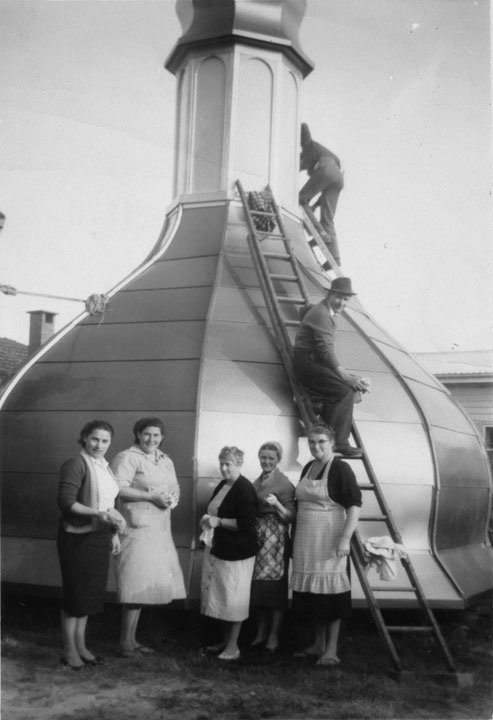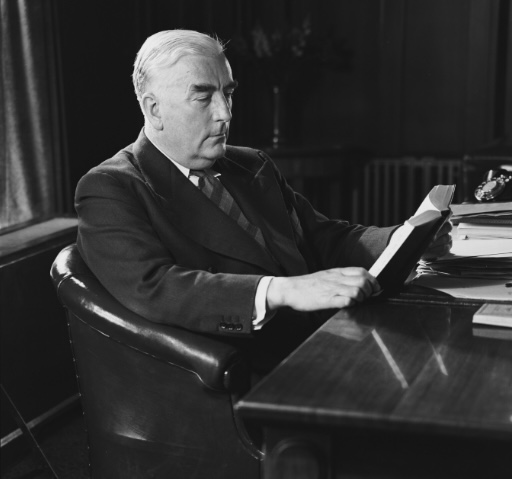On this day, 6 October 1959, Prime Minister Robert Menzies hosts Bishop Varlaam Solovij, head of the Ukrainian Autocelaphic Orthodox Church in Australia, for a meeting in Canberra. Bishop Solovij was an advocate for Ukrainian independence, but he was also representative of a large wave of migrants from Eastern Europe who helped to shape contemporary Australian views on communism and the Soviet Union during the early Cold War.
This wave of migration had been made possible by the fact that in the aftermath of the Second World War, the Australian Government decided to loosen the White Australia policy under the imperative of ‘populate or perish’ (the idea that a large population was necessary to defend such a vast landmass). This was something that Menzies, as Leader of the Opposition strongly supported, and indeed had advocated since before it became government policy. In one of his series of radio broadcasts delivered in April 1943, Menzies argued:
‘The greatest guarantee, not only of the safety of Australia but of its future material prosperity, would be a population of at least twenty million. If we are to rely on natural increase, this goal cannot be achieved for a century or two – and with our present population we may not hope to last so long as an independent people. The inevitable deduction from this is that we must have a positive, active and vigorous encouragement of migration. Yet, if you turn your minds back you will recall that for fifteen years before this war there was an attitude of mild hostility on migration into Australia. Are we proposing to resume this outlook when the war is over? Are we going to be timid about the temporary effect, social and industrial, of large migration, or are we to see in it a real source of strength? It is curious that a race so mixed as our own, which derives its strength and resilience from its mixture of English, Irish, Scots, Welsh, Cornish and, going back further, the Celt, the Angle, the Saxon, the Norman, should have become recently so sensitive about the purity of its blood. Migration into Australia, particularly from Northern European counties, will in the long run bring to us nothing but vigour and advantage.’
Some of the first new people allowed in under the more expansive immigration settings were displaced persons from Eastern Europe whose homelands had been absorbed into the Soviet Sphere. Under a carefully curated propaganda campaign called the ‘beautiful Balts’, the Chifley Government went out of its way to reassure the public that these new groups were not threatening and would be readily assimilated into Australian society.
One of the reasons why these migrants were successfully able to breakdown prejudices and ultimately earn acceptance in their adoptive country was because of their sympathetic refugee stories, with many bringing with them tales of Soviet Gulags and other atrocities that had been carried out by the Stalinist regime. A typical example was Dumitru Nimigeanu, whose Romanian village had been annexed by the Soviets in 1940, and who subsequently wrote a harrowing memoir of his time in a Russian prison camp.
Solovij had likewise faced persecution for his pro-independence views and come to Australia during the post war period. Even his name was provocative to the Russian regime, as his ecclesiastical adoption of the title Varlaam recalled a ‘national hero’ who had worked with Napoleon to set up an independent Ukraine in the early 19th century. This attempt proved short lived, and the man had been exiled to the Monastery of Novhozod Siversk, where the Australian bishop had happened to do his training. During this time, the original Varlaam’s old lodging was locked and referred to by Russian Guards as the ‘traitor’s cell’.
Given a platform by Menzies, the Australian Solovij told reporters that ‘many thousands of Ukrainians were now scattered all over the world — there are large Ukrainian colonies in the U.S.A. and Canada — and many had been forcibly deported to slave labour camps in Siberia, they hoped by their conduct to demonstrate that Ukrainians were worthy of their independence and had a capacity to conduct their own affairs.’ He also declared that there were ‘no greater supporters of Western Resistance to Communism than the many Ukrainians who experienced, with their own skins, the reality of Communist domination’.
Outside of advertising the Ukrainians’ plight, there was little the Menzies Government could do to advance their independence cause, but the government did commit to doing whatever it could to help relatives of Australian Ukrainians who were still living in the USSR to emigrate.
Further Reading:
‘Ukrainians Hope for Autonomy’, The Canberra Times, 6 October 1959, p.2. 06 Oct 1959 – Ukrainians Hope For Autonomy – Trove (nla.gov.au)
Jayne Persian, Beautiful Balts: From Displaced Persons to New Australians (Newsouth Publishing, 2017)
For information on Dumitru Nimigeanu’s story see Book of the Week Week 27: Hell moved its Border — Robert Menzies Institute
Further Listening:
Further Viewing:
Early Cold War Migration and its Impact on Australia – YouTube
Sign up to our newsletter
Sign up for our monthly newsletter to hear the latest news and receive information about upcoming events.


